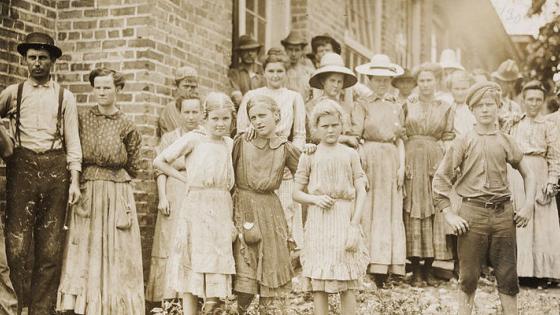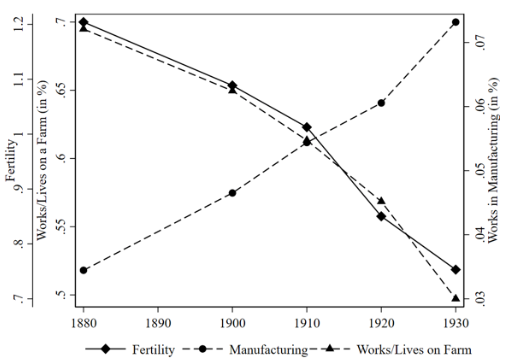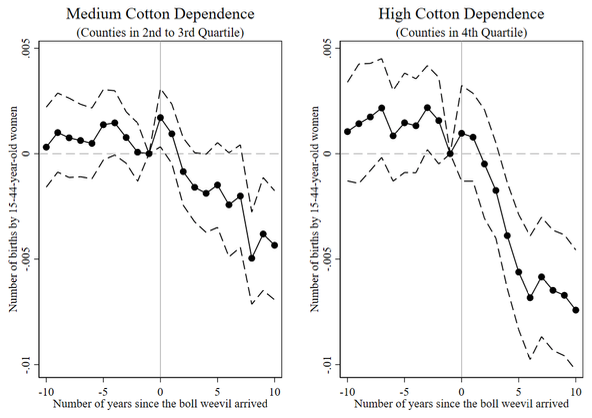The fertility transition that North American and European countries experienced during the 19th and 20th centuries is regarded as key to their economic success today. Falling fertility rates allowed these countries to escape the Malthusian world, where any economic gains were absorbed by a growing population and which resulted in relatively low living standards and constant levels of income per capita.
Cross-sectional evidence reveals that countries that experienced demographic transition – falling fertility and mortality rates – earlier have substantially higher levels of income per capita today (Galor 2012). Increased availability of historical data, such as digitised complete-count census samples for the US, has renewed the interest of economic historians and demographers in understanding what factors contributed to the historical fertility transitions in these countries.
One remarkable feature of countries that experienced falling fertility rates during the late-19th and early-20th centuries is that the fall went along with structural transformation in the form of a sustained shift from agriculture to manufacturing. Figure 1 shows this pattern for the American South. While theoretical work such as unified growth theory suggests that the structural transformation contributed to the onset of the fertility decline (Galor 2005), empirical evidence establishing a causal link is so far missing because identification is complicated, due to potential reverse causality and omitted variable bias.
In a recent paper (Ager and Herz 2019), we provide evidence that there was a causal link between structural transformation and fertility transition in the American South at the turn of the 20th century. Historically, the American South was an agrarian economy whose most important cash crop was cotton. As can be seen in Figure 1, in 1880, 70% of 10- to 65-year-olds reported to live or work on a farm, while fertility was high, at about 1.2 children under the age of 5 per 20- to 39-year-old married woman. The next 50 years were then characterised by a sustained shift from employment in agriculture to manufacturing and, at the same time, a sustained decrease in fertility.
Figure 1 Structural change and the fertility transition in the American South
Notes: This figure shows the evolution of the average number of children under age 5 per 20- to 39-year-old married woman, as well as the fraction of 10- to 65-year-olds employed in manufacturing or living/working on a farm, from 1880 to 1930, for the American South, based on full-count census data.
In order to empirically isolate the effect of structural change on fertility, our empirical strategy exploits the disruption of the Southern agricultural economy by an agricultural pest, the boll weevil. This vermin feeds almost exclusively on the cotton plant, the main economic engine of the American South at that time, and crossed from Mexico into the US near Brownsville, Texas in 1892. The boll weevil spread 40 to 160 miles per year, depending mainly on the prevailing wind and weather conditions. By 1922, the infestation reached its maximum extent when it covered almost the entire Cotton Belt region (Figure 2).
Because the vermin substantially damaged the cotton crop, infestation led to sharp declines in yields and cotton harvests, which changed earning opportunities in agriculture generally (e.g. Lange et al. 2009). Since the spread of the boll weevil was determined by geographic conditions, it provides a plausibly exogenous source of variation in agricultural-earnings opportunities that we can use to estimate its effect on fertility.
Figure 2 Spread of boll weevil in the American South, 1892 to 1922
Source: Hunter and Coad (1923).
We first demonstrate that the arrival of the boll weevil in a county led to substantial and persistent declines in fertility rates. Figure 3 shows that, in particular, counties that were heavily dependent on cotton production and where the boll weevil therefore was especially destructive experienced the strongest decline in fertility.
We then document that the boll-weevil infestation led to a substantial decline in agricultural income and triggered a shift from agriculture to manufacturing in the affected counties. Both results show that the boll weevil substantially reduced the earnings opportunities in the agricultural sector.
Figure 3 Dynamic effects of the boll weevil infestation on fertility
Notes: This figure shows the dynamic effects of the boll weevil infestation on fertility. The solid line depicts the effect on fertility relative to the base year, i.e the year before infestation. The left (right) panel shows the effect for medium (highly) cotton-dependent counties. Low-cotton-dependent counties are the reference group. Dashed lines indicate 90% confidence intervals.
The lower earnings opportunities in the agricultural sector triggered a fertility decline via two channels. First, households remaining in the agricultural sector reduced fertility from lower income, consistent with Becker’s (1960) suggestion that children are a ‘normal good’. Second, households switching to manufacturing reduced fertility because of the relatively higher costs of raising children associated with factory work. The two channels imply that there is an unambiguously negative association between lower earnings opportunities in agriculture and fertility.
We empirically disentangle these two channels by using a second exogenous source of agricultural production. Besides the boll-weevil infestation, we exploit the effect of the unprecedented increase in cigarette consumption during WWI on local tobacco cultivation. General Pershing, commander of the American Expeditionary Forces, regarded tobacco as essential for the morale of American soldiers in Europe and requested cigarettes to be part of the daily ration of American troops (Tate 2000). More than 5.5 billion manufactured cigarettes and enough tobacco to roll another 11 billion were shipped overseas. This surge in demand for tobacco is exogenous for local tobacco cultivators in the American South and serves as the second source of exogenous variation in the empirical analysis to properly identify and quantify the importance of both channels.
Our instrumental variables estimates are based on these two plausibly exogenous sources of agricultural production and show that the structural transformation had a causal and quantitatively important effect on the fertility transition. Our estimates reveal that the shift away from agriculture explains about 29% of the overall marital fertility decline in the American South during the late-19th and early-20th centuries.
The final part of the paper shows that the lower agricultural-earnings opportunities also reduced the value of child labour in the Cotton Belt of the American South. After the boll weevil entered a county, 10- to 15-year-old children were less likely to work and went to school instead. We show that the rise in school attendance was driven by a decline in the returns to child labour and not as a result of a potential increase in the attractiveness of schooling and the returns to education per se. The higher direct cost of having children decreased the opportunity cost of schooling, which reinforced the fertility decline.
This finding is consistent with a standard quantity-quality framework of fertility (Galor 2012), which predicts that an increase in the direct costs of having children (reduced household income from child labour) induces parents to invest more in the education (‘quality’) of their offspring. Our findings support the view that the quantity-quality framework can rationalise the well-documented rise in school enrolment that went along with structural change and the fertility transition during the last two centuries.
Conclusion
Our findings support the view that the structural transformation was an important determinant of the fertility transition during the late-19th and early-20th centuries. The lower earnings opportunities in agriculture contributed to a substantial fertility decline by accelerating the process of industrialisation and stimulating the demand for human capital.
References
Ager, P, and B Herz (2019), “Structural change and the fertility transition,” CEPR Discussion Paper 13609.
Becker, G S (1960), “An economic analysis of fertility,” in O C Ashenfelter and R Layard (eds.), Demographic and Economic Change in Developed Countries, Princeton, NJ: Princeton University Press.
Galor, O (2005), “From stagnation to growth: unified growth theory,” Handbook of Economic Growth 1: 171–293.
Galor, O (2012), “The demographic transition: causes and consequences,” Cliometrica 6(1): 1–28.
Guinnane, T W (2011), “The historical fertility transition: A guide for economists,” Journal of Economic Literature 49(3): 589–614.
Hunter, W D, and B R Coad (19230, “The boll-weevil problem,” USDA The Farmers’ Bulletin No. 1329.
Lange, F, A L Olmstead and P W Rhode (2009), “The impact of the boll weevil, 1892–1932,” The Journal of Economic History 69(3): 685–718.
Tate, C (2000), Cigarette wars: The triumph of the little white slaver, Oxford: Oxford University Press.





